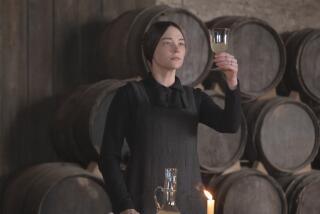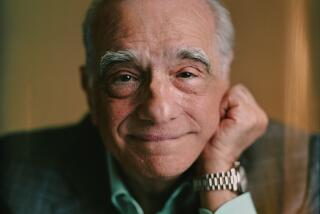A MYSTERIOUS ‘ROSE’ BLOOMS IN ROME
ROME — Ominous, gray clouds were hanging and swaying over the hilltops on the outskirts of this Eternal City and French director Jean-Jacques Annaud could not have been more pleased. “ Attenzione !,” he called in Italian to a crew readying a shot, not wanting to miss a moment of the eerie, natural atmosphere that he was counting on.
This would help re-create on film the mystery set in a 14th-Century Benedictine abbey by the Italian novelist Umberto Eco in “The Name of the Rose,” an international best-selling mystery that wraps later this month.
With the signal from Annaud, who directed “Black and White in Color” (which won an Oscar as best foreign-language film in 1976) and “Quest for Fire,” a procession of monks--smudges of black and beige on a gray background--moved hurriedly across an immense, realistic set said to be the largest built in Europe since “Cleopatra.” They rushed from one medieval facade to another, until they reached the scene of the latest in a series of terrible crimes.
The “monks,” actors gathered from around the world “with the proper faces and the ability to speak English,” were being led by F. Murray Abraham, playing a papal envoy sent to the abbey to head up an Inquisition.
This was one of two parallel stories that run through Eco’s complicated novel. The other, more prominent story, and the one this scene was being set up to tell, involves a series of seven murders that take place in the abbey and that are investigated by an English monk, William of Baskerville, played in the film by Sean Connery. Also featured are American actors William Hickey (the aged don of “Prizzi’s Honor” who’s Oscar-nominated for supporting actor) and Christian Slater, a young newcomer.
Common reactions to Eco’s 500-page novel have ranged from “breathtaking” to “Byzantine” to “unreadable.” With its many Latin references, Aristotelian illusions and labyrinth of monastic detail, it’s not surprising that U.S. publishers reportedly rejected Eco’s initial manuscript; when finally published, the novel even got off to a slow start in the writer’s native Italy. However, the mystery novel did go on to become a best seller and the film makers here admittedly were “gambling” that the film, six years, 14 scripts and four writers later, would build with audiences too.
“The moment I read just a summary of the story, I wanted to make the movie,” said Annaud, during a brief break from a non-stop, 14-week shooting schedule here, and, previously, in West Germany, where interior scenes in a real abbey were shot. Once more, I knew I was the only one who could make it, and I set out to convince Eco of this,” continued the director, 42, who said he studied ancient Greek, Latin, aesthetics and medieval history at the Sorbonne, while at the same time attending two French film institutes.
“I also had to convince him that a lot more than an understanding of medieval history was needed to adequately make a film out of his book. In order to reproduce this mystery, an extraordinary atmosphere is needed, and atmosphere costs a lot of money,” said Annaud, referring to the fact that the film rights to Eco’s novel initially were paid by Italian television for a projected miniseries.
Annaud said it was not until 1983 that the film rights were transferred to him, by way of a small French production company. And even then, he said, the French company “typically” flinched at the potential production costs.
“I feel like a foreigner in my own country,” said the director, referring to the “habits” that he said France and other European countries have formed regarding low-budget films aimed at limited, national markets and usually relegated to the “art house circuit” in the United States. “I don’t want to get awards for art films at film festivals. I want to make good films for Saturday night entertainment. By the same token, I believe audiences are intelligent enough to be give good entertainment.”
With this attitude, “good Hollywood contacts,” and an Oscar to his credit, Annaud said he made the rounds of the major Hollywood studios with the Eco project. “They all seemed interested, but not for the money I was asking,” he said, declining to say what he was asking for a pick-up deal with one of the studios. He pointed out that Fox was one of the first to show interest, an interest he said survived management transitions. It was under the current leadership of Barry Diller that the current deal with Fox to distribute the film in the States was sealed, according to Annaud, who added, “However, that deal came only very recently, and only when we had a final script and a cast to show them.”
Before the American distribution deal was sealed, Annaud had taken the film project to Bernd Eichinger, the West German distributor of “Quest for Fire.” Eichinger, 36, is one of the new generation of European film makers who, like Britain’s David Puttnam, has set out to revive the European industry.
Eichinger’s company provided the money that Annaud needed, including $4 million of Eichinger’s own funds, according to the director, and Eichinger became producer.
Eichinger did “The Neverending Story,” a 1983 film that he said has grossed nearly $100 million before cassette or cable-TV sales, becoming West Germany’s first international hit in decades.
Referring to it as “a prelude” to his future strategies, Eichinger said: “There is no ideology (behind my plans). It’s just that we in Europe have lost track of making movies for the world market, like we did before World War II, and I’d like to rectify this. The U.S. companies feed the world market as though it’s their local market, and there is no reason why we in Europe cannot do this too.
He acknowledged that “financing is the key,” including U.S. distribution deals with the major Hollywood studios, as well as a worldwide distribution strategy that “assures recoupment.”
Eichinger said that financing “Rose” involved, in addition to his own production funds, such worldwide distribution deals. In addition to Fox in the States, he said he has concluded deals with Columbia Pictures for distribution in Italy (the Italian film industry also provided co-production costs), as well as deals in France, Scandinavia, West Germany and Austria through his own distribution company, and he said negotiations were still under way for Japan and Spain. Eichinger said he has sold worldwide home video rights to the completed film to Embassy Communications.
“Talent, facilities, (film making principles) are the same everywhere,” Eichinger said of his worldwide strategies. “But you have to shoot in English, and choose subjects that are accessible to everyone.
“Either we in Europe are going to produce movies that are good, appealing, interesting, and not costly, and produce them for a limited market . . . or we are going to make movies like ‘Name of the Rose.’ ”
More to Read
Sign up for our Book Club newsletter
Get the latest news, events and more from the Los Angeles Times Book Club, and help us get L.A. reading and talking.
You may occasionally receive promotional content from the Los Angeles Times.









